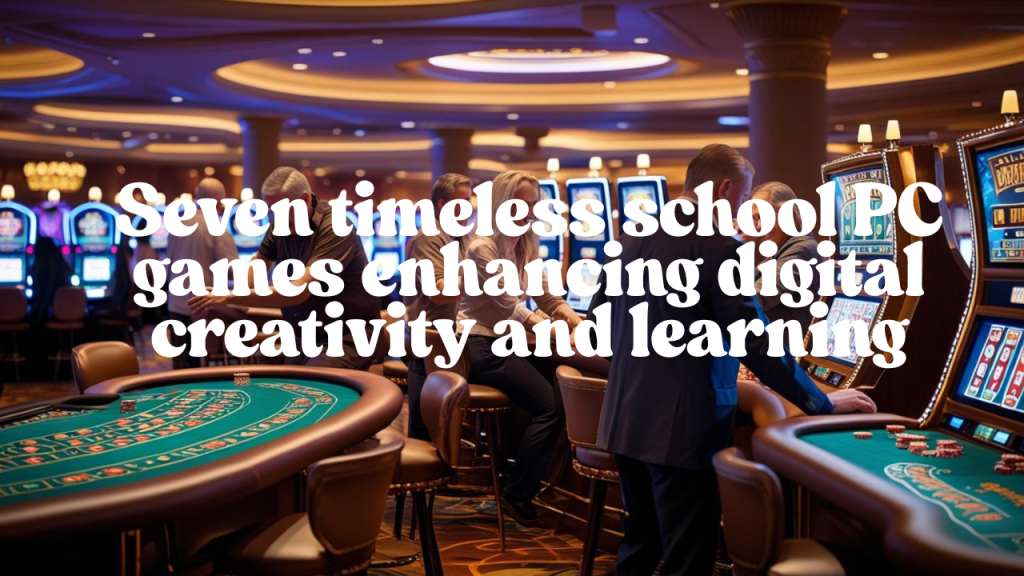School PC games remain a potent instrument for learning and cognitive growth in a time marked by online classes, e-learning systems, and smart devices. Although the concept of gaming in classrooms could have drawn criticism in the past, modern teachers and technology professionals see its ability to combine enjoyment with education.

School PC games provide pupils a dynamic, interesting substitute for conventional teaching approaches whether they are included into class plans, employed during free periods or computer lab sessions. This paper explores school PC games—those unforgettable digital tools that impacted classroom experiences, promoted critical thinking, and inspired development of ideas across generations. From more recent browser-based educational titles to ancient DOS-based learning tools, we investigate how these games added to the academic ecosystem and how you may bring them back into current schools.
The Learning Worth of School Computer Games
Computer lab sessions gave many students in the late 1990s and early 2000s chances to explore immersive, instructive worlds rather than only spreadsheets and typing drills. School PC games were unique in that they were gamified deliberately to promote arithmetic, reading, science, and logic.
School PC Games provide benefits in terms of increased engagement since they offer an active learning environment where students interact rather than only collecting knowledge passively.
Gamified content links teachings with interactive tasks, therefore enhancing long-term memory retention.
Natural elements of logical thinking, typing, problem-solving, and time management abound in gameplay.
Navigating these games taught children how to navigate simple software interfaces, a fundamental digital literacy ability.
These books were classroom allies, not just amusement with careful design and instructional compatibility.
Seven Classic School PC Games Designed to Make Learning Fun
These carefully chosen classic school PC games defined educational gaming and still appeal to both teachers and students.
1. the Oregon Trail
Without The Oregon Trail, no set list of classroom PC games is whole. This simulation mixed history with decision-making to teach pupils about pioneer life in the 19th century. The game tested critical thinking under duress whether it was for picking safe travel routes or food hunting.
Impact: Incorporated historical subjects with consequences-based gameplay.
2. Blaster in Mathematics
Math Blaster transformed numbers into an interstellar journey. Equation solving let gamers defeat alien dangers and aim targets. It was among the first games that make arithmetic actually fun.
Impact: Made basic arithmetic concepts attractive to students applying action-oriented learning.
3. Rider Rabbit for Readers
Targeted early learners, Reader Rabbit taught reading, phonics, and vocabulary using puzzles, stories, and appealing music.

Impact: Excellent early child literacy foundation tool.
4. Typing Instructor (Mavis Beacon)
Though not in the conventional sense, Mavis Beacon’s typing challenges were gamified to honour speed and accuracy. Learning keyboard skills became a competitive but inspiring hobby for me.
Effect: Develop measured and fun essential typing abilities.
Five: Carmen Sandiego Series
This detective game gently taught geography, culture, and reading comprehension by requiring players to follow hints and hunt criminals over worldwide places.
Impact: Promoted cultural awareness, deduction, and research.
Six. Zoombinis
Players of the visual logic game Zoombinis used math-based puzzles and pattern identification to aid eccentric creatures escape to safety.
Impact: strengthened problem-solving and reasoning free from heavy text.
7. Classic SimCity
a simulation in city development including urban planning, budgeting, resource management, and critical thinking.
Impact: Inspired innovation while offering understanding of socioeconomic systems.
How may one access these games in contemporary classrooms?
Originally designed for Windows 95 or MS-DOS, many educational PC games are incompatible with current computers without emulation or updated editions. This is how you bring them back:
First step: list legal sources in step-by-step manner.
Search for sites include GOG, Internet Archive, or educational software vendors. Re-release of many vintage games for contemporary systems is common.
Second step: apply an emulator.
Install older game emulators like DOSBox or ScummVM here. These utilities reproduce historical environments on current running systems.
Third step: set up a safe digital environment around you.
Make sure any download is done under IT control—ideally on off-peak or secured lab networks.
Fourth step: match games with curricula.
For further relevance, games like Reader Rabbit or SimCity might be included into English or social science course of instruction.
Step Five
Track Results and UsefulnessAnalyze how students interact with and remember knowledge from games. Consult follow-up worksheets or observations.
Why Should Teachers Give Gaming Another Thought as a Learning Tool?
Modern pedagogical study backs up the classroom’s inclusion of digital games. It’s about enhancing rather than about substituting textbooks.
Useful Ideas for Teachers:
Choose games driven by a purpose. Not every game is built equal. Select those consistent with learning objectives.
Create game-based challenges by matching in-game missions with outside projects or conversations.
Track development using gaming logs, score sheets, or digital portfolios.
Combining group projects, speeches, or reflective writing with gaming sessions will help to reinforce knowledge using blend learning.
Particularly when employed deliberately, school PC games can serve as accelerators for multidisciplinary learning.

School PC Games: FAQs
Q1: Are these still relevant in the classroom of today?
Yes. Basic games like Math Blaster and SimCity remain fit with fundamental learning goals even as technology has evolved.
Q2: Where legally could I obtain these games?
Among trusted sources are GOG com, Internet Archive, and academic publishers providing revised editions.
Q3: On Windows 10 or 11 will these games run?
Many can, using emulators like DOSBox or contemporary ports. Verify always the compatibility before starting.
Q4: Are these games fit for group learning?
Totally. Many titles can be used in group environments where students work through challenges or talk about results collectively.
Q5: Exists a contemporary equivalent of classroom PC games?
indeed. Modern, game-based learning opportunities abound on sites including Prodigy (math), Scratch (coding) and Kahoot! (quizzes).
Thoughts on Last Notes: Reviving Classic Learning Tools
School PC games are evidence of the potential of playful learning in an educational environment trying to strike a balance between involvement with results. Along with teaching generations, these digital encounters fostered a passion of inquiry, reason, and imagination.
We do more than just go back in time by carefully bringing them back into modern classrooms or home learning environments; we recover tested instruments that still inspire young brains. There is never a better opportunity to hit “Play” on the learning adventures of yesterday with easily available downloads, simple emulators, and clear instructional value.

Thus, regardless of your role—that of parent, teacher, or nostalgic gamer—give these books a new beginning and see how ageless lessons come to pass via the pleasure of play.


